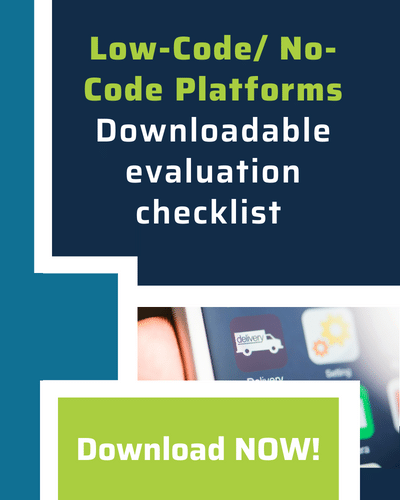Low code application development platforms have made quite a mark in the world of programming—revolutionizing the way that companies and developers work in the IT and software industry. Not only has low code taken away many of the challenges faced by companies using SAP ERP, such as time-consuming effort to write hundreds of thousands of lines of code to create apps, but it has also made manual processes automated.
Creating web applications has been completely streamlined through drag and drop interfaces, visual interfaces, and more. But what is low code application development, how did it originate, what challenges do coders face today and what low-code solutions are out there?
In this blog, low code application’s history and value will be explored as well as why Pillir’s low code rapid application development platform can increase the productivity of your business in the ERP SAP space.
History of Low Code
Low code can trace its roots back to fourth-generation programming language (4GL) as well as rapid app development tools (RAD) of the 1990s and early 2000s. This is around the time when web applications were becoming more popular, browsers became more complex, and there was a focus on functionality for applications. Modern languages were focused on helping developers speed up the development process, not spend hours searching for that one backslash they missed. Applications needed to be designed and deployed at a swifter pace, and languages had to be simple enough to support that.
So, what is low code application development?
Forrester Research was the first to eventually coin the term “low code” and defines it as “a platform [that] enables rapid delivery of business applications with a minimum of hand-coding and minimal upfront investment in setup, training, and deployment.”
In other words, low code app development is an approach to coding that allows users to create and manage applications quickly, automating the creation of web apps in a manner that makes their creation quick and effective.
Modern Day Coding Challenges
Companies adopting low-code platforms, such as EdgeReady Cloud, into their business workflows are eradicating various challenges with coding that previously got in the way of productivity. Understanding these challenges will help to understand the reason why low code platforms have become inevitable. Some modern-day coding challenges include:
- Manual Processes: creating applications manually gives way to human errors, which causes a domino effect of larger business issues as a result. Coders have to spend hours trying to look for one line of code that might’ve disrupted everything.
- Development Time: the development time of web applications that are manually coded is typically an arduous and time-consuming process, taking an average of 4.5 months to complete.
- Employee Experience: the coders attempting to develop the apps are faced with very dry, tedious work which proves not to be attractive to newcomers entering the workforce.
- Lack of Integration: manually built apps typically can’t be integrated to third-party tools such as SAP or SFDC.
What are the Benefits of Low Code App Development?
So, how can low code application development help solve these common challenges encountered in modern day coding? For one, it can remove the pain of manually-produced, technical tasks and gives back valuable time to accomplish more important things. Instead of trying to locate that one piece of code amongst hundreds of thousands of coding language, employees can contribute to a business in other more productive ways. Here are some ways that low code can solve common coding challenges:
- Drag-n-Drop Interfaces: easy to navigate interfaces known by low code platforms, such as EdgeReady Cloud, allow developers to work effortlessly and quickly.
- Cut Development Time by 50%-90%: according to 451 Research, low code platforms can cut 50%-90% of development time when compared to a coding language. This is invaluable time saved for you and your team.
- Customization: coders dedicated to building apps on your team can now enjoy a customizable platform with pre-built design templates and the ability to import existing designs without interfering with performance or functionality.
- Integration: easy to implement APIs and connectors integrate with third-party tools such as SAP and SFDC that developers use already- making it possible for them to focus on building incredible web apps quickly and in sync with existing systems.
- Improve User Experience: since low code solutions make it fast and simple to create or update apps, it also makes it possible to respond to customer and client feedback quickly! You can make the necessary adjustments to your applications faster, thus improving the overall user experience and increasing customer satisfaction.
- Attainable Digital Transformation: low code app development makes digital transformation attainable in organizations no matter how small or large. Digitize existing workflows and processes by quickly building modernized apps that will help reduce costs, save time, increase productivity and enhance quality.
Who Can Use Low Code App Development Platforms?
Professional Developers
There’s a common misconception that professional developers dislike using low code development platforms because it inhibits creativity. On the contrary, low code platforms allow professional developers to expand upon existing apps or build them from scratch. It helps to automate certain functions that have been recognized as tedious and mundane, giving professional developers more time to focus on creative processes and pushing the boundaries for digital innovation.
Professional developers and IT departments also feel the pressure to modernize the existing architecture of an organization, but are expected to simultaneously respond to incoming requests for building new solutions and apps to support other departments and organizational functions. Naturally, bottlenecks are bound to occur. This is where a low code platform can help! It provides the option for professional developers to quickly build or enhance apps, or it gives citizen developers the opportunity to do so!
Citizen Developers
Citizen developers are business users that have little to no experience or formal knowledge in coding and building applications. However, they are placed in such a role because they need to build apps to support business processes and functions. While the concept of citizen developers is not new, it is becoming more prevalent in organizations as the need for faster solutions continues to grow. A recent Gartner report states that at least 61% of organizations are planning to or have already incorporated citizen development initiatives into their operations.
Using drag-n-drop interfaces, Pillir’s low code platform, EdgeReady Cloud, helps support citizen developers in building custom apps they need to support their roles, business processes, workflows and much more. It enhances speed-to-market, reduces costs and makes it easy to adjust or improve the functionality for a better user experience. While extensive coding knowledge is not a requirement when using EdgeReady Cloud, having some low-level coding experience is helpful and strongly recommended.
Explore Low Code Application Development with Pillir
Now that the game-changing features of low code platforms have been outlined, it’s important to understand what options are out there and why low code is the right choice.
One of these options includes EdgeReady Cloud. EdgeReady Cloud (ERC) helps to build apps faster, smarter, and more efficiently. Using cloud scalability, resiliency, and security, it offers pre-built features and functions, contributing to overall productivity for your business.
Users can easily generate apps with little-to-no programming or extend to the ERC with code where needed. Additionally, users can access it in any connectivity landscape, whether online or offline.
Pillir also offers another product called Modernize SAP ERP, the #1 ABAP Cost Analysis App for SAP ERP customers. It not only helps SAP customers identify ABAP technical debt, but also evaluates the total cost of ownership and rate of change in order to create business justifications for modernization. Modernize SAP uses the power of EdgeReady Cloud to help SAP ERP customers easily identify, manage and migrate ABAP non-core modifications. Sounds like a no-brainer, right?
If you’d like to save time, money and improve efficiency overall at your business, the switch from manual coding to a low code application development approach has never been an easier decision.
Learn more about EdgeReady Cloud low code application platform by scheduling a use case call. Contact our team today.




 Back
Back/Logo%20-%20black%20text%20blue%20pillar%20(large)-1.jpg)

